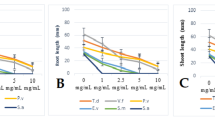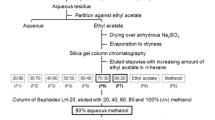Abstract
Annonaceae is one of the richest families of the wood components of the Brazilian savanna (Cerrado). Annona coriacea Mart., Annona crassiflora Mart., Duguetia furfuracea (A. St.-Hil.) Saff. and Xylopia aromatica L. are common species in this region. The main goal of our study was to determine biological activities of these species. Therefore, we evaluated phytotoxic effects of ethanolic extracts of leaves and stems of these species in the laboratory. In addition, toxicity to animal targets was also evaluated. Lettuce was the less affected target species, with discreet effects over germination rate and initial root development observed using the highest concentration (0.8 mg mL−1) of extracts of A. coriacea. Notwithstanding, tomato was the most affected target species by these annonaceous extracts, with an expressive decrease in germination rate, shoot and root growth even with the lowest extract concentrations. Onion germination was affected mainly by X. aromatica and A. coriacea leaf extracts, with significant results for all concentrations. Effects on shoot and root growth were also observed for this species. In general, the strongest phytotoxic activities were detected for the extracts of A. coriacea and X. aromatica. These extracts also inhibited growth of Urochloa decumbens (Stapf) R.D. Webster. The extracts of A. coriacea were also very toxic to brine shrimp nauplii. No antibacterial or antifungal effects were detected with the extracts of these four species of Annonaceae. Among the four species, X. aromatica and A. coriacea exhibited strong biological activities and the results could be useful in agricultural fields in Brazil. These extracts were also promising for isolation and identification of commercial valuable metabolites.





Similar content being viewed by others
References
Alvim MJ, Botrel MA, Verneque RS, Salvatti JA (1990) Aplicação de nitrogênio em acessos de braquiária. 1. Efeito sobre a produção de matéria seca. Pasturas Trop 12:2–6
Batalha MA, Mantovani W (2001) Floristic composition of the cerrado in the Pé-de-Gigante Reserve (Santa Rita do Passa Quatro, Southeastern Brazil). Acta Bot Bras 15:289–304
Batalha MA, Aragaki S, Mantovani W (1997) Florística do cerrado em Emas (Pirassununga, SP). Bol Bot Univ São Paulo 16:49–64
Chatrou LW, Pirie MD, Erkens RHJ, Couveur TLP, Neubig KM, Abbott JR, Mols JB, Maas JW, Saunders RMK, Chase MW (2012) A new subfamilial and tribal classification of the pantropical flowering plant Family Annonaceae informed by molecular phylogenetics. Bot J Linn Soc 169:5–40
Costa MS, Pinheiro DO, Serrão JE, Pereira MJB (2012) Morphological changes in the midgut of Aedes aegypti L. (Diptera: Culicidae) larvae following exposure to na Annona coriacea (Magnoliales: Annonaceae) extract. Neotrop Entomol 41:311–314
DaSilva DM, Batalha MA (2011) Defense syndromes against herbivory in a Cerrado plant community. Plant Ecol 212:181–193
Dayan FE, Cantrell CL, Duke SO (2009) Natural products in crop protection. Bioorgan Med Chem 17:4022–4034
Farooq M, Jabran K, Cheema ZA, Wahid A, Siddique KHM (2011) The role of allelopathy in agricultural pest management. Pest Manag Sci 67:493–506
Fernandes CN, Souza HHF, Borges MCM, Souza CES, Huedes GMM, Figueredo FG, Tintino SR, Costa JGM, Coutinho HDM, Menezes IRA, Felipe CFB, Kerntopf MR (2014) Evaluation of the modulatory and antibacterial activity of the ethanolic extract and fractions of Duguetia furfuracea A. St.-Hil. Afr J Pharm Pharmacol 8:16–20
Ferreira AG (2004) Interferência: competição e alelopatia. In: Ferreira AG, Borghetti F (eds) Germinação: do básico ao aplicado. Artmed, Porto Alegre, pp 251–264
Ferreira AG, Aquila MEA (2000) Alelopatia: uma área emergente de ecofisiologia. Rev Bras Fisiol Veg 12:175–204
Formagio ASN, Masetto TE, Baldivia DS, Vieira MC, Zárate NAH, Pereira SV (2010) Potencial alelopático de cinco espécies da família Annonaceae. R Bras Bioci 8:349–354
Forzza RC, Leitman PM, Costa A, Carvalho AA Jr, Peixoto AL, Walter BMT, Bicudo C, Zappi D, Costa DP, Lleras E, Martinelli G, Lima HC, Prado J, Stehmann JR, Baumgratz JFA, Pirani JR, Sylvestre LS, Maia LC, Lohmann LG, Paganucci L, Silveira M, Nadruz M, Mamede MCH, Bastos MNC, Morim MP, Barbosa MR, Menezes M, Hopkins M, Secco R, Cavalcanti T, Souza VC (2010) Catálogo de plantas e fungos do Brasil. Instituto de Pesquisas Jardim Botânico do Rio de Janeiro, Rio de Janeiro
Freitas AF, Pereira FF, Formagio ASN, Lucchetta JT, Vieira JT, Mussury RM (2014) Effects of methabolic extracts of Annona species on the development and reproduction of Spodoptera frugiperda (J E Smith) (Lepidoptera: Noctuidae). Neotrop Entomol 43:446–452
Gniazdowska A, Bogatek R (2005) Allelopathic interactions between plants. Multi site action of allelochemicals. Acta Physiol Plant 27:395–407
Gravito G, Rincón J, Arteaga L, Hata Y, Bourdy G, Gimenez A, Pinzón R, Deharo E (2006) Antimalarial activity of some Colombial medicinal plants. J Ethnopharmacol 107:460–462
Hancock CR, Barlow HWB, Lacey HJ (1964) The east malling coleoptile straight growth test method. J Exp Bot 15:166–176
Haridasan M (2001) Nutrient cycling as a function of landscape and biotic characteristics in the cerrado of central Brazil. In: McClain ME, Victoria RL, Richey JE (eds) Biogeochemistry of the Amazon basin and its role in a changing world. Oxford University Press, New York
Imatomi M, Novaes P, Matos A, Gualtieri SCJ, Molinillo JMG, Lacret R, Varela RM, Macias FA (2013) Phytotoxic effect of bioactive compounds isolated from Myrcia tomentosa (Myrtaceae) leaves. Biochem Syst Ecol 46:29–35
Inoue MH, Santana DC, Pereira MJB, Possamai ACS, Azevedo VH (2009) Aqueous extracts of Xylopia aromatica and Annona crassiflora on marandu grass (Brachiaria brizantha) and soybean. Sci Agrar 10:245–250
Lorenzi H (2000) Plantas daninhas do Brasil. Instituto Plantarum, Nova Odessa
Macías F, Castellano D, Molinillo JMG (2000) Search for a standard phytotoxic bioassay for allelochemicals. Selection of standard target species. J Agric Food Chem 48:2512–2521
Macías FA, Molinillo JMG, Varela RM, Galindo JCG (2007) Allelopathy—a natural alternative for weed control. Pest Manag Sci 63:327–348
Macías FA, Oliveiros-Bastidos A, Marin D, Carrera C, Chinchilla N, Molinillo JMG (2008) Plant biocommunicators: their phytotoxicity, degradation studies and potential use as herbicide models. Phytochem Rev 7:179–194
Macías FA, Lacret R, Varela RM, Nogueiras C, Molinillo JMG (2010) Isolation and phytotoxicity of terpenes from Tectona grandis. J Chem Ecol 36:396–404
Mantovani W, Martins FR (1993) Florística do cerrado na reserva biológica de Moji Guaçu, SP. Acta Bot Bras 7:33–60
Moreira A (2000) Effects of fire protection on savanna structure in Central Brazil. J Biogeogr 27:1021–1029
Nitsch JP, Nitsch C (1956) Studies on the growth of coleoptile and first internode sections. A new sensitive, straight-growth test for auxins. Plant Physiol 31:94–111
Novaes P, Varela RM, Molinillo JMG, Macias FA (2013a) Phytochemistry of Cerrado (Brazilian savanna) plants. Phytochem Rev 12:839–855
Novaes P, Imatomi M, Varela RM, Molinillo JMG, Lacret R, Gualtieri SCJ, Macias FA (2013b) Allelopathic potential of extracts from Rapanea umbellata. Chem Biodivers 10:1539–1548
Omena MC, Navarro DMAF, Paula JE, Luna JS, Lima MRF, Sant’Ana AEG (2007) Larvicidal activities against Aedes aegypti of some Brazilian medicinal plants. Bioresour Technol 13:2549–2556
Osorio E, Arango GJ, Jimenez N, Alzate F, Ruiz G, Gutiérrez D, Paco MA, Giménez A, Robledo S (2007) Antiprotozoal and cytotoxic activities in vitro of Colombian Annonaceae. J Ethnopharmacol 111:630–635
Pimenta LPS, Pinto GB, Takahashi JA, Silva LGF, Boaventura MAD (2003) Biologiocal screening of Annonaceous Brazilian medicinal plants using Artemia salina (Brine shrimp Test). Phytomedicine 10:209–212
Resende GC, Alvarenga ES, Galindo JCG, Macias FA (2012) Synthesis and phytotoxicity of 4.5 functionalized tetrahydrofuran-2-ones. J Braz Chem Soc 23:2266–2270
Rial C, Novaes P, Varela RM, Molinillo JMG, Macías FA (2014) Phytotoxicity of Cardoon (Cynara cardunculus) allelochemicals on standard target species and weeds. J Agric Food Chem 62:6699–6706
Rodrigues AMS, Paula JED, Degallier N, Molez JF, Espindola LS (2006) Larvicidal activity of some cerrado plant extracts against Aedes aegypti. J Am Mosq Contr 22:314–317
Santos AF, Sant’Ana AEG (2001) Molluscidal properties of some species of Annona. Phytomedicine 8:115–120
Singh A, Singh D, Singh NB (2009) Allelochemical stress produced by aqueous leachate of Nicotiana plumbaginifolia Viv. Plant Growth Regul 58:163–171
Solis PN, Wright CW, Anderson MM, Gupta MP, Phillipson JD (1993) A microwell cytotoxicity assay using Artemia salina (brine shrimp). Planta Med 59:250–252
Souza LS, Velini ED, Maiomoni-Rodella RCS (2003) Efeito alelopático de plantas daninhas e concentrações de capim-braquiária (Brachiaria decumbens) no desenvolvimento inicial de eucalipto (Eucalyptus grandis). Planta Daninha 21:343–354
Souza Filho AP, Rodrigues LR, Rodrigues TJD (1996) Efeitos de extratos aquosos de assa-peixe sobre a germinação de três espécies de braquiária. Planta Daninha 14:93–101
Tempone AG, Barborema SET, Andrade HF, Gualda NCA, Yogi A, Carvalho S, Bachiega D, Bonotto SV, Ficher DCH (2005) Antiprotozoal activity of Brazilian plant extracts from isoquiline alkaloid-producing families. Phytomedicine 12:382–390
Zar JH (2010) Biostatistical analysis. Prentice Hall, Upper Saddle River
Acknowledgments
We are grateful to Conselho Nacional de Desenvolvimento Científico e Tecnológico (CNPq) for a Ph. D fellowship to PB Torres, and a research fellowship to DYAC Santos, as well as to Coordenação de Aperfeiçoamento de Pessoal de Nível Superior (CAPES) for a research fellowship to P Novaes, to Fundação de Amparo à Pesquisa do Estado de São Paulo (FAPESP) for financial support (Process: 2013-07543-0), to MS Jenifer Lopes for help with plant harvesting, to Professor Regina Lúcia Madini (Instituto de Química – USP) for donation of initial inoculum of bacteria, and to Laboratório de Ecofisiologia de Sementes da Universidade Federal de São Carlos for donation of Fusarium oxysporum.
Author information
Authors and Affiliations
Corresponding author
Rights and permissions
About this article
Cite this article
Novaes, P., Torres, P.B. & dos Santos, D.Y.A.C. Biological activities of Annonaceae species extracts from Cerrado. Braz. J. Bot 39, 131–137 (2016). https://doi.org/10.1007/s40415-015-0225-z
Received:
Accepted:
Published:
Issue Date:
DOI: https://doi.org/10.1007/s40415-015-0225-z




